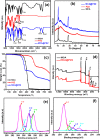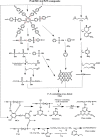Thermal Stability, Pyrolysis Behavior, and Fire-Retardant Performance of Melamine Cyanurate@Poly(cyclotriphosphazene- co-4,4'-sulfonyl diphenol) Hybrid Nanosheet-Containing Polyamide 6 Composites
- PMID: 31460052
- PMCID: PMC6648528
- DOI: 10.1021/acsomega.9b00346
Thermal Stability, Pyrolysis Behavior, and Fire-Retardant Performance of Melamine Cyanurate@Poly(cyclotriphosphazene- co-4,4'-sulfonyl diphenol) Hybrid Nanosheet-Containing Polyamide 6 Composites
Abstract
A novel halogen-free highly cross-linked supramolecular poly(cyclotriphosphazene-co-4,4'-sulfonyl diphenol) (PZS)-functionalized melamine cyanurate (MCA) (MCA@PZS) hybrid nanosheet fire-retardant (FR) was synthesized and thoroughly characterized using scanning electron microscopy, Fourier-transform infrared (FTIR), X-ray diffraction, and X-ray photoelectron spectroscopy analyses. The polyamide 6 (PA6) composites comprising MCA, PZS, and the MCA@PZS hybrids were prepared via the melt-blending technique. The thermogravimetric analysis combined with FTIR and mass spectroscopy revealed that during thermal degradation, the PA6/MCA@PZS composites released less toxic gases and small organic volatile compounds than the neat PA6 and composites containing MCA or PZS solely. Moreover, compared to neat PA6, the PA6 composite with a 5 wt % MCA@PZS hybrid exhibited enhanced fire retardation properties, with a 29.4 and 32.1% decrease in the peak heat and total heat release rates, respectively. Besides, the PA6 composites with MCA@PZS-5% content achieved a V-0 rating in the UL-94 test. Finally, based on the obtained results from gaseous and condensed phases, the possible mechanism responsible for improved FR properties of the PA6/MCA@PZS composites was proposed.
Conflict of interest statement
The authors declare no competing financial interest.
Figures













References
-
- Meng H.; Sui G. X.; Xie G. Y.; Yang R. Friction and wear behavior of carbon nanotubes reinforced polyamide 6 composites under dry sliding and water lubricated condition. Compos. Sci. Technol. 2009, 69, 606–611. 10.1016/j.compscitech.2008.12.004. - DOI
-
- Hu Y.; Wang S.; Ling Z.; Zhuang Y.; Chen Z.; Fan W. Preparation and combustion properties of flame retardant nylon 6/montmorillonite nanocomposite. Macromol. Mater. Eng. 2003, 288, 272–276. 10.1002/mame.200390017. - DOI
-
- Liu Y.; Wang Q. The investigation on the flame retardancy mechanism of nitrogen flame retardant melamine cyanurate in polyamide 6. J. Polym. Res. 2009, 16, 583–589. 10.1007/s10965-008-9263-6. - DOI
-
- Wu Z.-Y.; Xu W.; Liu Y.-C.; Xia J.-K.; Wu Q.-X.; Xu W.-J. Preparation and characterization of flame-retardant melamine cyanurate/polyamide 6 nanocomposites byin situpolymerization. J. Appl. Polym. Sci. 2009, 113, 2109–2116. 10.1002/app.30022. - DOI
LinkOut - more resources
Full Text Sources
Other Literature Sources

